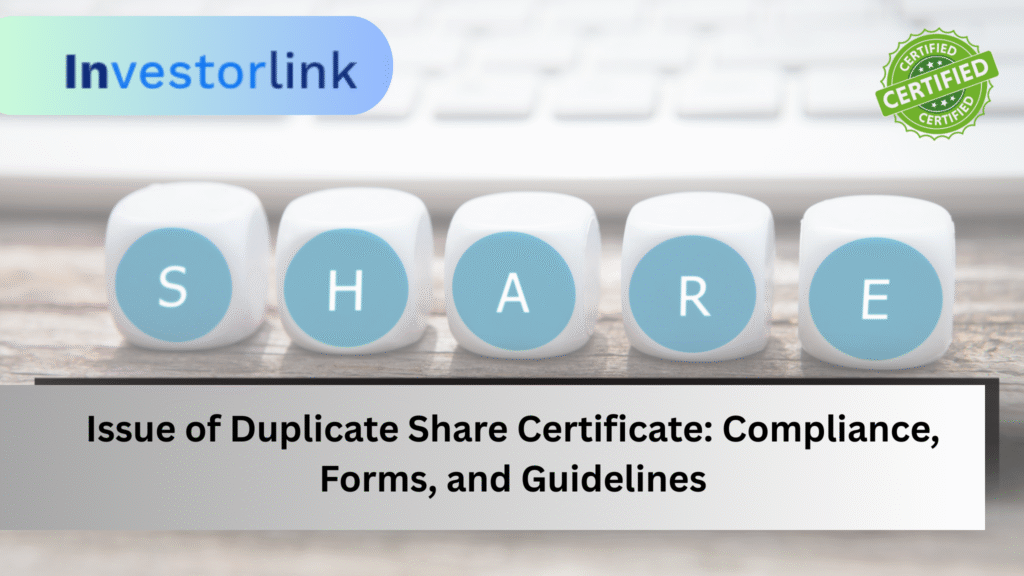
A share certificate is an essential legal document issued by a company to its shareholders, representing ownership in that company. It contains critical details such as the shareholder’s name, number of shares, distinctive numbers, and date of issue. However, due to misplacement, theft, loss, or damage, shareholders may require the issue of duplicate share certificate. The process is governed by strict compliance measures under the Companies Act, 2013 and the rules prescribed by the Ministry of Corporate Affairs (MCA).
This article explains in detail the compliance requirements, forms, and guidelines involved in the issue of duplicate share certificate in India.
Legal Framework for Issue of Duplicate Share Certificate
The Companies Act, 2013 read with the Companies (Share Capital and Debentures) Rules, 2014 regulates the issue of duplicate share certificates. As per Section 46(2), a company may issue a duplicate certificate if the original one is:
- Lost or misplaced, or
- Defaced, torn, or mutilated and returned to the company.
The process ensures authenticity, protects shareholders from fraud, and maintains accurate records in the Register of Members.
Circumstances Leading to Issue of Duplicate Share Certificate
A shareholder may need a duplicate share certificate in the following situations:
- Loss of certificate due to misplacement or theft.
- Damage caused by fire, water, or mishandling.
- Mutilated or torn certificate where details are illegible.
- Natural calamities leading to loss of important documents.
In each case, the shareholder must follow the due procedure laid down by the company and statutory guidelines.
Read More: Trusted Consultants for Recovery of Shares from IEPF
Step-by-Step Process for Issue of Duplicate Share Certificate
1. Intimation to the Company
The shareholder must immediately notify the company or its Registrar and Transfer Agent (RTA) about the loss or damage of the certificate.
2. Submission of Application
A formal application must be submitted along with a request letter stating the reason for issuing a duplicate.
3. Supporting Documents
Depending on the cause, documents may include:
- FIR copy in case of loss or theft.
- Indemnity Bond executed by the shareholder.
- Affidavit on non-judicial stamp paper confirming the loss.
- Newspaper advertisement, if required by the company.
- Damaged/mutilated original certificate (if available).
4. Board Approval
The Board of Directors must approve the issue of duplicate certificates in a duly convened meeting.
5. Payment of Fees
Shareholders may need to pay nominal charges as prescribed by the Articles of Association of the company.
6. Issue of Duplicate Certificate
Once approved, the company issues the duplicate certificate within the statutory timeline and records the details in:
- Register of Renewed and Duplicate Share Certificates (Form SH-2).
- Register of Members.
Timelines for Issuing Duplicate Share Certificate
According to the Companies (Share Capital and Debentures) Rules, 2014:
- A listed company must issue a duplicate certificate within 45 days from the date of submission of complete documents.
- For unlisted companies, the timeline is 3 months from submission.
Compliance Requirements
Companies must adhere to the following compliance obligations:
- Board Resolution – Mandatory approval of the Board before issuing a duplicate share certificate.
- Entry in SH-2 Register – Details of duplicate certificates must be recorded with serial numbers and reasons.
- Certification – Duplicate certificate must be clearly stamped or marked as “Duplicate” on the face.
- Shareholder’s Signature Verification – The company verifies the authenticity of the shareholder’s signature.
- Filing with Registrar – Certain cases may require filing e-Form MGT-7 (Annual Return) containing certificate details.
Forms and Documents Involved
The following are commonly used in the process of issuing duplicate share certificates:
- Form SH-2 – Register of Renewed and Duplicate Share Certificates.
- Board Resolution Format – Approval of issuance in the board meeting.
- Indemnity Bond – Undertaking by the shareholder indemnifying the company.
- Affidavit – Statement confirming loss or damage of the certificate.
- FIR/Police Report – Proof of loss in case of theft or misplacement.
- Newspaper Advertisement – In some cases, the company may require publication notice.
Penalties for Non-Compliance
If a company fails to follow due procedure, it may attract penalties under the Companies Act, 2013.
- The company may be fined up to ₹25,000.
- Every defaulting officer may face a penalty of up to ₹5,000.
Thus, timely compliance is crucial to avoid regulatory issues.
Role of Professionals in the Process
The process of issue of duplicate share certificate involves multiple steps, legal documentation, and regulatory compliance. Engaging a professional consultant, company secretary, or share recovery expert helps ensure:
- Accurate preparation of affidavits and indemnity bonds.
- Smooth liaison with the company or RTA.
- Avoidance of delays and rejection due to incomplete documentation.
Key Guidelines for Shareholders
- Always keep photocopies or scanned copies of share certificates for record.
- Immediately file an FIR in case of theft or loss.
- Submit documents without delay to the company or RTA.
- Ensure the duplicate certificate is marked “Duplicate” to prevent misuse.
Conclusion
The issue of duplicate share certificate is a well-structured process under Indian corporate law, ensuring both shareholder protection and corporate governance. By following the compliance requirements, filing the necessary forms, and adhering to prescribed guidelines, shareholders can secure their rightful ownership even in case of loss or damage to original certificates.
Professional assistance can further simplify the procedure, reduce delays, and safeguard against future disputes.
In today’s era of dematerialisation, shareholders are also encouraged to convert physical share certificates into demat form to avoid the risk of loss, theft, or damage in the future.
Also Read: Eligibility Criteria to Affidavit for name change in share certificate




